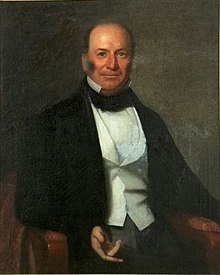James Hopkins Adams
| James Hopkins Adams | |
|---|---|
 |
|
| 66th Governor of South Carolina | |
|
In office December 11, 1854 – December 9, 1856 |
|
| Lieutenant | Richard de Treville |
| Preceded by | John Lawrence Manning |
| Succeeded by | Robert Francis Withers Allston |
| Member of the South Carolina Senate from the Richland District | |
|
In office November 24, 1851 – November 27, 1854 |
|
| Member of the South Carolina House of Representatives from the Richland District | |
|
In office November 27, 1848 – November 25, 1850 |
|
|
In office December 9, 1840 – November 28, 1842 |
|
|
In office November 24, 1834 – November 26, 1838 |
|
| Personal details | |
| Born |
March 15, 1812 Minervaville, South Carolina |
| Died | July 13, 1861 (aged 49) Live Oak Plantation, Richland District, South Carolina |
| Resting place | St. John's Congaree Episcopal Church, Congaree, South Carolina |
| Spouse(s) | Jane Margaret Scott |
| Children | Eleven children |
| Alma mater | Yale University |
| Committees | Signer of the Ordinance of Secession |
| Military service | |
| Allegiance |
|
| Service/branch | South Carolina state militia |
| Rank | Brigadier General |
| Commands |
|
James Hopkins Adams (March 15, 1812 – July 13, 1861) was an American politician from South Carolina. He served in the South Carolina Legislature and was the 66th governor of the state.
Adams was born in Minervaville, South Carolina, in 1812 to Henry Walker Adams and Mary Goodwyn Adams. Both of his parents had died by the time James was three years old, and therefore he was raised by his grandfather, Joel Adams, the patriarch of the Adams family of South Carolina. He graduated from Yale College in 1831.
In 1832, he joined the South Carolina Nullification Convention which deliberated until 1833 on whether states could nullify federal laws. He was an opponent of nullification.
He was a member of the South Carolina House of Representatives from 1834 to 1837, 1840 to 1841, and 1848 to 1849. In 1850, he was elected to the South Carolina Senate, where he stayed through 1853. He served as a brigadier general of the South Carolina Militia.
In 1854, Adams was elected the 66th Governor of South Carolina, a position he held through 1857. In 1856, he recommended a resumption of the foreign slave trade as a way of eliminating illicit trade. The legislature rejected this proposal.
He signed the articles of secession for South Carolina, The Ordinance of Secession, and served as a member of the commission to the United States government to negotiate the transfer of United States property in South Carolina to the state government.
He married Jane Margaret Scott in April 1832. They had 11 children. Among his many children was Lt. Colonel Warren Adams, of the Confederate States Army, who was in command of Battery Wagner, South Carolina during the American Civil War.
...
Wikipedia
